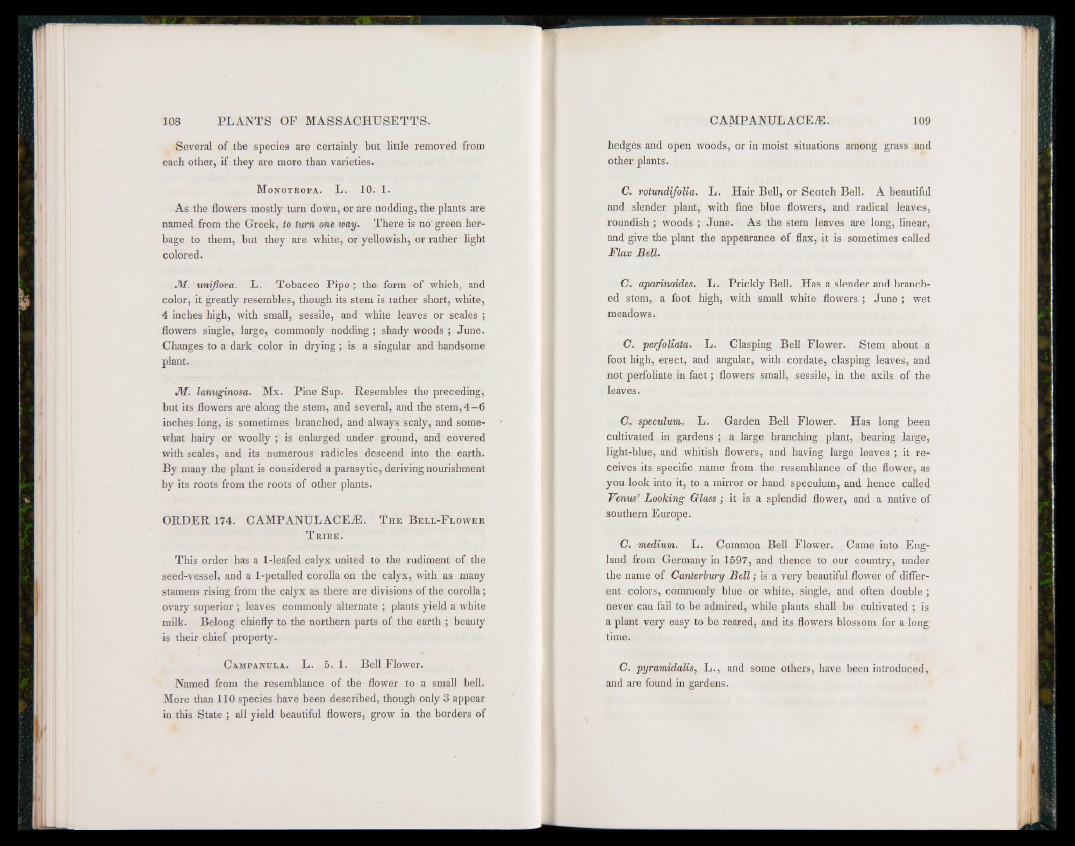
Several of the species are certainly but little removed from
each other, if they are more than varieties.
M onotropa. L. 10. 1.
As the flowers mostly turn down, or are nodding, the plants are
named from the Greek, to turn one toay. There is no' green herbage
to them, but they are white, or yellowish, or rather light
colored.
J\f. unijlora. L. Tobacco Pipe ; the form of which, and
color, it greatly resembles, though its stem is rather short, white,
4 inches high, with small, sessile, and white leaves or scales ;
flowers single, large, commonly nodding ; shady woods ; June.
Changes to a dark color in drying; is a singular and handsome
plant.
J\f. lanuginosa. Mx. Pine Sap. Resembles the preceding,
but its flowers are along the stem, and several, and the stem,4 -6
inches long, is sometimes branched, and always scaly, and somewhat
hairy or woolly ; is enlarged under ground, and covered
with scales, and its numerous radicles descend into the earth.
By many the plant is considered a parasytic, deriving nourishment
by its roots from the roots of other plants.
ORDER 174. CAMPANULACEiE. T he B e l l - F lower
T r ib e .
This order has a 1-leafed calyx united to the rudiment of the
seed-vessel, and a 1-petalled corolla on the calyx, with as many
stamens rising from the calyx as there are divisions of the corolla;
ovary superior ; leaves commonly alternate ; plants yield a white
milk. Belong chiefly to the northern parts of the earth ; beauty
is their chief property.
C ampanula. L. 5. 1. Bell Flower.
Named from the resemblance of the flower to a small bell.
More than 110 species have been described, though only 3 appear
in this State ; all yield beautiful flowers, grow in the borders of
hedges and open woods, or in moist situations among grass and
other plants.
C. rotundifolia. L. Hair Bell, or Scotch Bell. A beautiful
and slender plant, with fine blue flowers, and radical leaves,
roundish ; woods ; June. As the stem leaves are long, linear,
and give the plant the appearance of flax, it is sometimes called
Flax Bell.
C. aparinoides. L. Prickly Bell. Has a slender and branched
stem, a foot high, with small white flowers ; June ; wet
meadows.
C. perfoliata. L. Clasping Bell Flower. Stem about a
foot high, erect, and angular, with cordate, clasping leaves, and
not perfoliate in fa c t; flowers small, sessile, in the axils of the
leaves.
C. speculum. L. Garden Bell Flower. Has long been
cultivated in gardens ; a large branching plant, bearing large,
light-blue, and whitish flowers, and having large leaves ; it receives
its specific name from the resemblance of the flower, as
you look into it, to a mirror or hand speculum, and hence called
Venus’ Looking Glass; it is a splendid flower, and a native of
southern Europe.
C. medium. L. Common Bell Flower. Came into England
from Germany in 1597, and thence to our country, under
the name of Canterbury B e ll; is a very beautiful flower of different
colors, commonly blue or white, single, and often double;
never can fail to be admired, while plants shall be cultivated ; is
a plant very easy to be reared, and its flowers blossom for a long
time.
C. pyramidalis, L., and some others, have been introduced,
and are found in gardens.